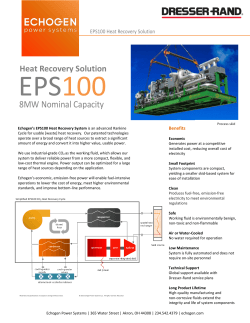
Study on potential biphasic solvents: Absorption capacity, CO2
Available online at www.sciencedirect.com Energy Procedia 37 (2013) 494 – 498 GHGT-11 Study on potential biphasic solvents: Absorption capacity, CO2 loading and reaction rate Xu Zhicheng, Wang Shujuan*, Zhao Bo and Chen Changhe Key Laboratory for Thermal Science and Power Engineering of Ministry of Education, Department of Thermal Engineering, Tsinghua University, Beijing, China Abstract For its high potential in reducing energy penalty of power plant, the biphasic absorption system for CO2 capture has attracted more and more attentions. Only few solvents, however, are reported to be suitable for this system. Meanwhile, as the previous researchers have pointed out, besides CO2 loading and reaction rate, absorption capacity should also be considered when we evaluate new solvents. In this paper, therefore, 12 potential single or mixed amine solutions for biphasic system are studied by comparing their maximum CO2 loading, absorption capacity, and the reaction rate. The results could be useful in the biphasic CO2 capture system in the future. © 2013 Authors. Published by Elsevier © 2013 TheThe Authors. Published by Elsevier Ltd. Ltd. Selection and/or peer-review under responsibility of GHGT Selection and/or peer-review under responsibility of GHGT Key words: CO2 capture;biphasic solvent;absorption capacity; reaction rate; loading 1. Introduction As global climate change is becoming a more important issue, technologies of reducing CO2 emission is attracting more attention. Several different kinds of technologies exist for CO2 capture. Among them, amine-based absorption is the most common one today, due to its high flexibility and easy retrofit for existing power plant [1]. Development of solvent with high efficiency is regarded as one of the most crucial issues for post combustion capture. Many solvents, such as monoethanolamine(MEA), methyldiethanolamine(MDEA), diethanolamine(DEA) and piperazine(PZ), have been applied to capture CO2[2][3][4]. However, this process always requires lots of energy during desorption. Therefore, the problem is, how to reduce the energy penalty of the absorption-desorption system, and then how to reduce * Corresponding author. Tel.: +86-10-62788668; fax: +86-10-62770209. E-mail address: wangshuj@tsinghua.edu.cn. 1876-6102 © 2013 The Authors. Published by Elsevier Ltd. Selection and/or peer-review under responsibility of GHGT doi:10.1016/j.egypro.2013.05.135 495 Xu Zhicheng et al. / Energy Procedia 37 (2013) 494 – 498 the cost. Recently, some novel concepts, such as DMXTM[5] and lipophilic amine solvents[6], have been proposed for the improvement of the energy performance. Zhang et al[7] did screening tests of DMA, DMCA and other solvents, Tan[8] studied kinetics and thermodynamic of the blend of DPA and DMCA, and they found the cyclic loading of this solvent can reach 0.7 mol CO2/mol amine. Raynal el al[5] proposed the concept of DMX process, which, according to their previous simulation, can remarkably reduce the heat duty of reboiler to 2.3GJ/tCO2. Bruder el al[9] found that the 5M DEEA and 2M MAPA blend can get two phases after CO2 absorption and the cyclic loading was higher than that of 5M MEA. For the biphasic system, it is an important issue that whether the solution will become two liquid phases after absorption. In this paper, 12 single or mixed amine solutions with different concentration, as shown in Table 1, were used to absorb CO2 in a semi-batch reactor with the volume of about 150ml. And the maximum CO2 loading, absorption capacity, and the reaction rate of the 12 solutions were measured. The individual loading of the two phases were titrated for those biphasic solutions. Table 1 studied amines: CAS number and aqueous concentration Solvent Solvent No. 1 2 3 4 5 6 7 8 Solvent CAS No. Abbreviation Concentration (mol/L) N-Ethylethylenediamine EEDA 110-72-5 N,N-Diethylethanolamine DEEA 100-37-8 N,N-Dimethyl-1,3-propane diamine DMPDA 109-55-7 N,N-Diethylethanolamine DEEA 100-37-8 1,4-Diaminobutane DAB 110-60-1 N,N-Diethylethanolamine DEEA 100-37-8 N,N-Dimethylbutylamine DMBA 927-62-8 N,N-Diethylethanolamine DEEA 100-37-8 Hexylamine HA 111-26-2 N,N-Diethylethanolamine DEEA 100-37-8 3/2, 4/1.8, 2/5, 1.6/4, 2/4, 2/4.5 2/4, 2/5 2/4 2/4 2/4 1,6-Hexanediamine HDA 124-09-4 N,N-Diethylethanolamine DEEA 100-37-8 N-Methyl-1,3-propanediamine MAPA 6291-84-5 Triethylamine TEA 121-44-8 N-Methyl-1,3-propanediamine MAPA 6291-84-5 2.3 N,N-Dimethylbutylamine DMBA 927-62-8 2 2/4 2/3 9 Hexylamine HA 111-26-2 2.2 10 Hexylamine HA 111-26-2 3 11 1,4-Diaminobutane DAB 110-60-1 3 12 1,6-Hexanediamine HDA 124-09-4 3 During the experiment, pure CO2 was induced into the solution at atmospheric pressure and temperature at a relatively slow but constant rate to avoid solution loss due to reaction heat. When the weight increased less than 0.02 g per minute, the experiment stopped. The CO2 loading and absorption capacity for one phase solvents were calculated according to the weight increased. We observed whether two liquid phases appeared and checked the weight of the solution. For the biphasic solvents, CO2 loading and amine concentration of each phase were titrated by barium chloride precipitation method and sulphuric acid respectively. 496 Xu Zhicheng et al. / Energy Procedia 37 (2013) 494 – 498 2. Results and Discussion 2.1 The best concentration of solvent 1 and solvent 2 For solvent 1 and solvent 2, as shown in Table 1, several different concentrations were measured. Fig. 1(a) and (b) tells the absorption capacity and maximum CO2 loading of them, respectively. Fig.1(a) indicates that 4mol/L EEDA + 1.8mol/L DEEA can reach the highest capacity and highest loading among all the tested concentrations, while Fig.1(b) shows that 2mol/L DMPDA + 4mol/L DEEA is better than 2mol/L DMPDA + 5mol/L DEEA, due to the precipitation of the solution at higher concentration. Thus the result of the 2mol/L DMPDA + 4mol/L DEEA is presented in Fig. 2 to compare with the other solvents. (a) solvent 1 (b) solvent 2 Fig.1 Comparison of different concentration of solvent 1 and solvent 2 The reason why 4mol/L EEDA + 1.8mol/L DEEA performed better than others is that EEDA has two amino groups, and the more amine contained in the solution, the higher the absorption capacity attained. However, at relatively higher amine concentration, the rich loading decreased. Precipitation is an important drawback for absorption capacity of the solution. For the mixed solution of DMPDA and DEEA, at the higher concentration of 2mol/L DMPDA + 5mol/L DEEA, the solution precipitated while approaching relatively high loading, so the rich loading and absorption capacity were limited. 2.2 Comparisons of different solvents In order to compare the reaction rate of different solvents at different stages, the average reaction rate of first 10 minutes and 120 minutes were selected. Fig. 2 shows the comparison of the solvents from No.2 to No.12. Reaction rate_10 is the mean reaction rate for first 10 minutes, and reaction rate_120 is the one for first 120 minutes. The figure reveals that solvent No. 3 has the biggest absorption capacity, 3.8mol/L solution. Possible reason is that DAB is a di-amine, and the total amine concentration is high. For CO2 loading, the two single di-amines, No.11 and 12 are much better than the others. For absorption rate, solvent No.12 has highest reaction rate_10, and solvent No.11 has the highest reaction rate_120. 497 Xu Zhicheng et al. / Energy Procedia 37 (2013) 494 – 498 Fig.2 Comparison of different studied solvents During the experiment, it was found that solvents, No.1 with concentration of 2mol/L DMPDA + 5mol/L DEEA and No.6 produced precipitation, so the absorption capacity, loading and reaction rate are the value before precipitation. The solvents No. 1 with concentration of 2mol/L EEDA + 4.5mol/L DEEA, No. 3, No.4, No.7 and No.8 became two liquid phases after CO2 absorption. The amine concentration and CO2 loading for the two phases are titrated respectively. The results are listed in Table 2. Table 2 titration results of biphasic solvents Solvent No. amine concentration (mol/kg) CO2 loading (mol/mol alkalinity) 1 upper phase 6.44 0.20 1 lower phase 8.62 0.33 3 upper phase 8.10 0.026 3 lower phase 8.00 0.43 4 upper phase 7.57 0.032 4 lower phase 4.76 0.79 7 upper phase 7.90 0.023 7 lower phase 6.86 0.53 8 upper phase 6.69 0.0036 8 lower phase 5.70 0.51 From Table 2, it is obvious that for most of the biphasic solvents, the amine concentrations of the upper and lower phase are almost same, while the CO2 loading of the two phases are very different. This kind of solvents, especially solvent 4, may be suitable for the biphasic system. 498 Xu Zhicheng et al. / Energy Procedia 37 (2013) 494 – 498 3. Conclusion 12 single or mixed amine solutions with different concentration were used to select potential biphasic solvents. The absorption capacity, rich loading and absorption rate of them were measured and compared, the individual loading of the upper and lower phase for the biphasic solvents were titrated. The results show that two di-amines, 3M DAB and 3M HAD, performed better than others when comprehensively considering the absorption capacity, absorption rate and rich loading. The experiments also find a biphasic solvents with better performance than others, 2M DMBA+4M DEEA, which may be suitable for the biphasic system. References [1] Gary T. Rochelle. Amine scrubbing for CO2 capture. Science 2009;325:1652-1654 [2] Edward B. Rinker, Sami S. Ashour et al. Absorption of carbon dioxide into aqueous blends of diethanolamine and methyldiethanolamine. Ind. Eng. Chem. Res. 2000;39:4346-4356. [3] P.W.J. Derks, H.B.S. Dijkstra et al. Solubility of carbon dioxide in aqueous piperazine solutions. Thermodynamics 2005;51:2311 2327. [4] Sanjay Bishnoi, Gary T. Rochelle. Absorption of carbon dioxide in aqueous piperazine/methyldiethanolamine. American Institute of Chemical Engieers.AIChE Journal 2002;48:2788 2799. [5] Ludovic Raynal, Pascal Alix et al. The DMXTM process: An original solution for lowering the cost of post-combustion carbon capture. Energy Procedia 2011;4:779 786. [6] Xiaohui Zhang. Studies on multiphase CO2 capture system. Ph.D dissertation.University of Dortmund, 2007. [7] Jiafei Zhang, David W. Agar et al.CO2 absorption in biphasic solvents with enhanced low temperature solvent regeneration. Energy Procedia 2011;4:67 74. [8] Yudy Halim Tan. Study of CO2-absorption into thermomorphic lipophilic amine solvents. Ph.D dissertation.University of Dortmund, 2010 [9] Peter Bruder, Hallvard F. Svendsen. Solvent comparison for postcombustion CO2 capture. 1st Post Combustion Capture Conference. Abu Dhabi, Kingdom of Saudi Arabia. May 17-19, 2011.
© Copyright 2025









